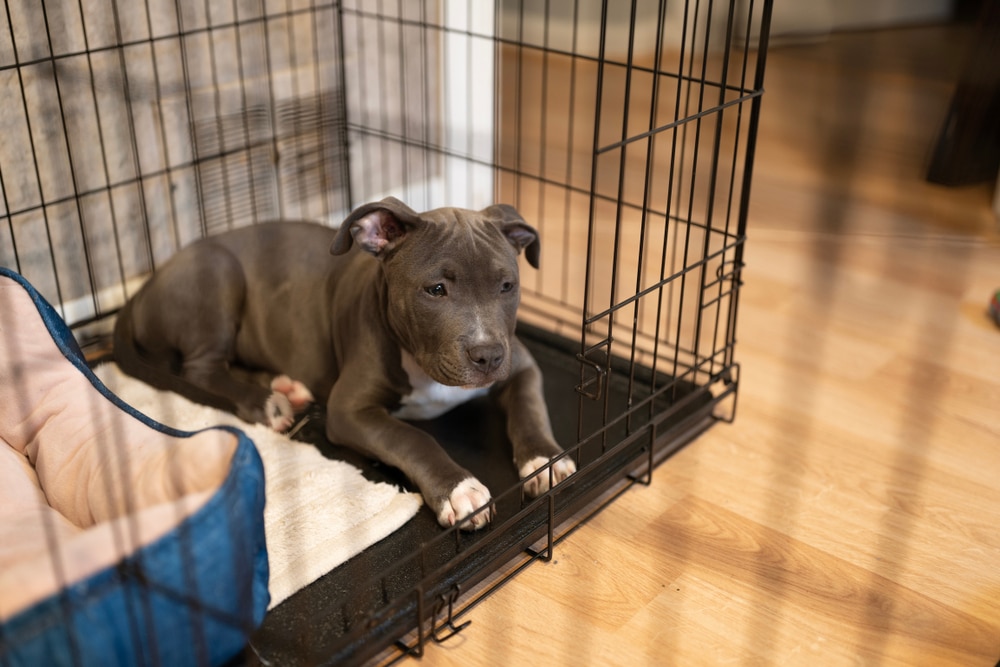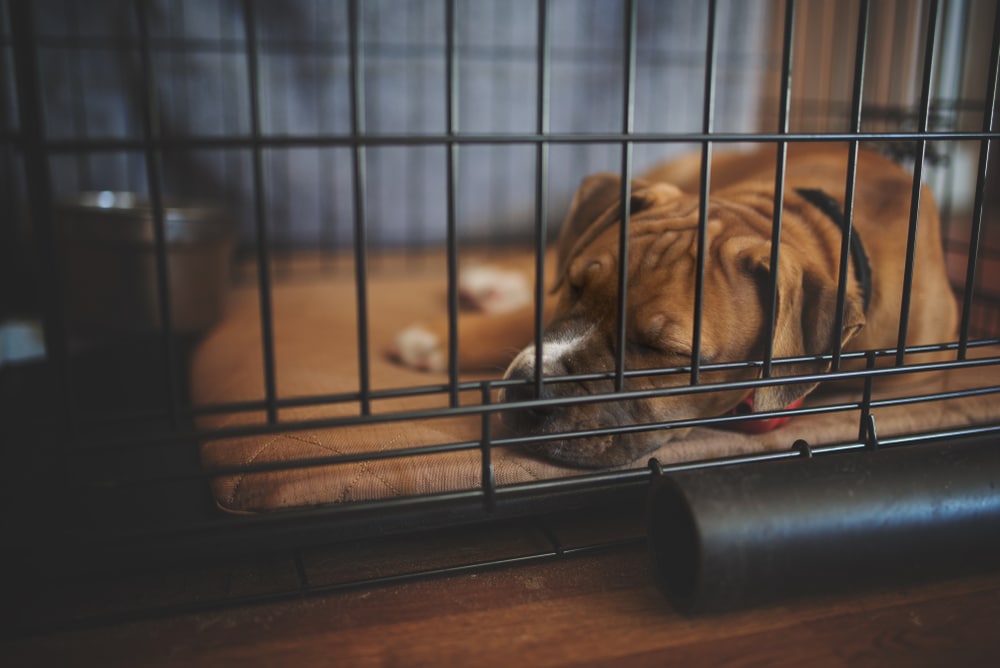Sometimes, puppies can be challenging. A crate can be a safe, effective solution to many of the problems they face and cause. But you may also be wondering if it is cruel to leave your friend “locked up” in a crate, so to say. So, let’s answer that question: is crate training inhumane?
Crate training is not inhumane. It creates a safe and relaxing place for your dog. When properly adapted to the crate, a dog will feel comfortable inside the crate. It will also remain calm during the night or during a time out.
Table of Contents
What Is Crate Training?
Crate training is the process of making your dog accept a crate as a safe and familiar environment for it to relax and stay in when needed – like in travels or during the night, for example. While it may seem a little awkward for humans, dogs have a natural denning instinct inherited from wolves. For them, a den represents a shelter where they can be safe from the adversities of the world.
However, crate training a dog has to be done correctly and patiently otherwise it can become inhumane. When looking for a crate, you can choose between different materials, such as plastic, metal, and fabric, and the size must be big enough to allow the dog to stand, lie down, and turn around comfortably.
Why Should I Crate Train My Dog?

The main reasons to crate train your dog are related to training, safety, transportation, and protection. Let’s start with training.
Training
A crate is a useful tool to help with general training. If you are potty training your puppy or teaching it that is not allowed to chew the furniture, restricting the space can help a lot.
Safety
The safety of the crate will contribute to your dog being less stressed. Besides being a place to relax, it is a secure space to hide during stressful events, such as holidays and thunderstorms.
Transportation
A crate-trained dog will be much easier to transport and will be much more comfortable in a different environment (such as a groomer or veterinarian) because they are inside a place they know and feel safe in.
Protection
A dog in a crate is in a limited space and can’t get to toxic substances. Your friend will be protected against injuries and poisonings while you are not at home.
Is Crate Training Unpleasant?
If you do everything correctly, respect the signs your dog gives and be patient, crate training should not be unpleasant. As with any other training, your dog may have some trouble in the beginning understanding what you want from it, so it’s really important to follow the process step by step and to take a step back when needed.
When the training is complete, the dog will feel comfortable inside the crate and will view it as a safe space. So, it is actually very considerate and humane to crate-train your dog. Inside the crate, there are no unexpected stimuli, no stressful situations, and no potential harmful dangers. So, it becomes a place where your pet can rest and be transported while feeling safe.
Also, keep in mind that a dog has a natural denning instinct, so the crate will become its shelter. Besides, the pet will only spend limited time inside the crate, so it’s not like a prison at all.
How Do I Crate Train My Dog?
There are a few steps you can follow to master the crate training of your dog. Let’s start with introducing the crate.
Introduce The Crate
In this first step, you want to make sure your dog gets to know the crate and has a positive association with it. Make sure you choose a spot that is calm enough to rest, but that is close to the family. An example is the corner of the living room, for example. Once you place the crate, let the door open (making sure it is secured and will never shut by accident) and let your dog explore.
Some dogs will take longer than others to feel comfortable around an unknown object, but the important thing in this step is to always reward your buddy when it gets near or inside the crate. To help your friend feel comfortable with it, you can put its favorite toy or a delicious treat around the crate. You can also put some nice blankets on the inside to make it more appealing.
Also, never force your dog into the crate because you want it to be a place with no association with stress. Respect its time and praise it a lot for every little advancement it makes. When your puppy is going in and out of the crate freely and easily, move on to the next step.
Feed Your Dog Meals In The Crate
Once your dog is comfortable with getting in and out of the crate, you can start to feed it its meals inside the crate. This will develop a positive association with the place and provide a pleasant experience for your dog. Sometimes, your buddy will start to go in the crate automatically at meal times, which is a very good sign.
Before serving the meal, introduce a cue word to get your friend to go in the crate, like “go to crate” or “bed”. This way, the dog will start to associate the command with the action and will know that it needs to get inside the crate when the command is said.
Close The Door While Your Dog Is Inside The Crate
If your dog already seems comfortable eating inside the crate, you can move to the next step and start to close the door during mealtime. At first, make sure you open the door right after your puppy is done eating. Praise it a lot for staying there during that time as well. Over time, you can start to leave the door closed for a few minutes after your dog is finished eating. Just remember to stay by its side during this step, and reward it for being calm in the crate.
If your buddy stops eating when you close the door or seems more tense or anxious, try only touching the door or holding it half open at the beginning. Once it stays relaxed with this situation, you can fully close the door.
Step Away From The Crate
Once your dog is comfortable with staying in the crate with the door closed after its meals, you can start to step away for a few minutes. You may want to start with only moving a few feet away though. To help, you can put some toys or treats inside the crate to keep your pet distracted and pleased during your time away.
Increase How Long They Stay In The Crate
If your dog has successfully mastered the previous steps and doesn’t show any sign of stress or anxiety when you step away, it is time to move on to the next challenge: leaving it in the crate for longer periods of time.
Start with 30 minutes to an hour being present in the same room. You can do the training while you watch a movie, for example. Then you can release your dog after 30 minutes of good behavior. Then change it to leave the pet inside the crate for more time and without you in its sight. At this point, your dog will be probably used to the cue word or words you chose, so you can also give the command at other times of the day.
The important thing in this step is to provide a good first experience in the crate. Praise your pet a lot during its time inside, and don’t ever let it out due to bad behavior (such as whining or barking). You don’t want them to associate whining or barking with being released from the crate.
Leave The House
Once your dog is able to spend some hours inside the crate with good behavior, without feeling stressed or vocalizing, you can start to leave the house. Start with short trips before progressing to longer ones and, if you are able to, leave a camera on during your time away. That way, you can make sure your dog is staying relaxed and calm while you’re gone and is not having a bad experience.
Even when all the training is done and you are able to leave your dog inside whenever you need to, make sure to leave the crate open during free time so your dog can get in and relax. Remember that the crate must be a comfortable and safe place for your pet with a positive association.
How To Avoid A Negative Experience?
To ensure your dog is not going to have a bad association with the crate, the most important thing to do is never use it as a punishment. Remember: you want the crate to be a safe and relaxing space for your dog.
During the crate-training process, always be attentive to the signs your dog is showing you, and don’t hesitate to step back as many times as you need if you notice any tension, stress, or anxiety. Also, keep in mind these steps are meant to be done for a few weeks and not for a few days.
In addition, remember that although a crate-trained dog will be totally comfortable inside the crate, it should not be kept crated for too long, so keep the maximum time to four to six hours. Also, make sure your dog is never, ever wearing a collar or anything else inside the crate that might get caught or hurt them. That way, you guarantee it can’t get stuck or hurt while you’re not watching it.
Conclusion: Is Crate Training Inhumane?
In conclusion, crate training is the opposite of inhumane. It provides a safe place for your dog to rest during your time out and for them to hide in stressful situations. It also facilitates transportation, it keeps your dog protected from injuries and poisoning, and it helps with house training. If you do it properly, crate training your dog will result in a lot of benefits for both of you.
So, do you plan on crate training your dog? Let us know your thoughts and why in the comments below!
